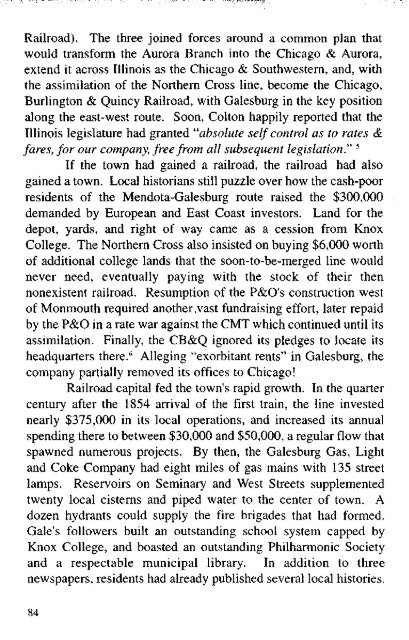"The Cruel Striker War" - NIU Digital Projects
"The Cruel Striker War" - NIU Digital Projects
"The Cruel Striker War" - NIU Digital Projects
Create successful ePaper yourself
Turn your PDF publications into a flip-book with our unique Google optimized e-Paper software.
Railroad). <strong>The</strong> three joined forces around a common plan that<br />
would transform the Aurora Branch into the Chicago & Aurora,<br />
extend it across Illinois as the Chicago & Southwestern, and, with<br />
the assimilation of the Northern Cross line, become the Chicago,<br />
Burlington & Quincy Railroad, with Galesburg in the key position<br />
along the east-west route. Soon, Colton happily reported that the<br />
Illinois legislature had granted "absolute self control as to rates &<br />
fares, for our company, free from all subsequent legislation." 5<br />
If the town had gained a railroad, the railroad had also<br />
gained a town. Local historians still puzzle over how the cash-poor<br />
residents of the Mendota-Galesburg route raised the $300,000<br />
demanded by European and East Coast investors. Land for the<br />
depot, yards, and right of way came as a cession from Knox<br />
College. <strong>The</strong> Northern Cross also insisted on buying $6,000 worth<br />
of additional college lands that the soon-to-be-merged line would<br />
never need, eventually paying with the stock of their then<br />
nonexistent railroad. Resumption of the P&O's construction west<br />
of Monmouth required another vast fundraising effort, later repaid<br />
by the P&O in a rate war against the CMT which continued until its<br />
assimilation. Finally, the CB&Q ignored its pledges to locate its<br />
headquarters there. 6 Alleging "exorbitant rents" in Galesburg, the<br />
company partially removed its offices to Chicago!<br />
Railroad capital fed the town's rapid growth. In the quarter<br />
century after the 1854 arrival of the first train, the line invested<br />
nearly $375,000 in its local operations, and increased its annual<br />
spending there to between $30,000 and $50,000, a regular flow that<br />
spawned numerous projects. By then, the Galesburg Gas, Light<br />
and Coke Company had eight miles of gas mains with 135 street<br />
lamps. Reservoirs on Seminary and West Streets supplemented<br />
twenty local cisterns and piped water to the center of town. A<br />
dozen hydrants could supply the fire brigades that had formed.<br />
Gale's followers built an outstanding school system capped by<br />
Knox College, and boasted an outstanding Philharmonic Society<br />
and a respectable municipal library. In addition to three<br />
newspapers, residents had already published several local histories.<br />
84

















